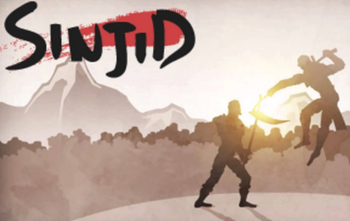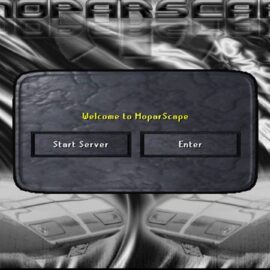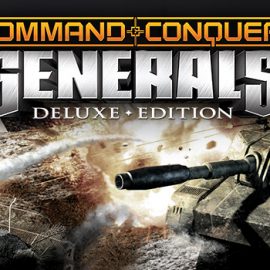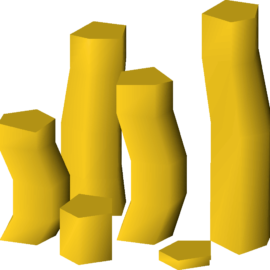Disclosure: I may earn affiliate revenue or commissions if you purchase products from links on my website. The prospect of compensation does not influence what I write about or how my posts are structured. The vast majority of articles on my website do not contain any affiliate links.
I’m twenty-six years old. When I was beginning to use a computer without supervision back in 2005, Flash games were one of the most entertaining things one could find on the internet. I still remember the day that we upgraded to broadband internet. The first website I visited was Addicting Games.
Flash had its golden age. By the time you read this, it’ll be but a memory, as it will reach end-of-life and support will be dropped from modern browsers. Seeing as I’m home at my parents’ house for Christmas, this felt appropriate. I enjoy passing the time by playing the games from my childhood, so I worked my way through the Sinjid trilogy.
Sinjid Trilogy
Creator: “Krin”
Sinjid: Battle Arena (August 2003)
Sinjid: Shadow of the Warrior (December 2004)
Sinjid (2013)
Sinjid: Battle Arena
The series’ creator, Krinn, published a compelling Flash RPG that has been played millions of times. From what I can tell, this was his first game.
Combat is instanced through a portal. There are 25 different bosses to defeat on the hardest difficulty level, called terminator. The game map consists of three rooms. One where you can buy upgrades, one where you can upgrade your gear and spend skill points, and one with the portal.
The gear is limited and the leveling system is primitive. The experience points you can gain don’t accrue toward a traditional level-up scheme. Rather, the points can be spent on a skill tree comprised of 9 active skills and 6 passive skills.
Though the second game in the series would be classified as turn-based, combat in Battle Arena actually uses a tick system. If you don’t do anything, your opponent will attack you and kill you. If you click too slowly, your opponent will also probably win.
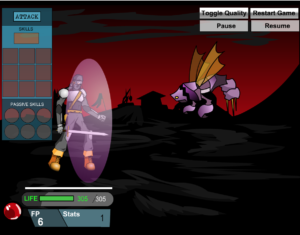
In your first battle, you start by spamming the ‘attack’ button until your opponent dies. Enemy HP isn’t displayed by default, it’s unlocked via a passive skill that becomes available during the mid-game. There’s no movement involved and not much skill required once you make it to battle. What makes this game precious, and what gave it serious appeal in its era, is that timers and cooldowns were not mainstream in Flash games at the time.
The timing of attacks was a big part of the game. If you timed your attack perfectly you could dodge certain opponents’ attacks while delivering damage, or even parry an opponent’s attack. Upgrading speed is one of the most useful upgrades there is. However, the primitive nature of this mechanic means that when your AI foe is faster than you, the battles can become extremely frustrating. The game demands spam clicking as your cooldown wears off–I’ve noticed reaction delays in the hundreds of milliseconds on the human end can change the tide of battle.
After each battle, you get some exp and gold. Unfortunately, battles aren’t repeatable and there’s no way to get exp or gold outside of the portal. So, if you poorly choose your gear or choose awful skills, you can get “stuck” on a certain level in the portal. When you lose, you can retry, but you cannot leave the instance you’re in. So, even if you have extra gold lying around, you can’t take a breather, you either have to reload a saved game or start over.
The game’s difficulty curve is reasonable for 2003 but would be considered cruel in 2020. The difficulties forcibly end your game after 5-10-15-20-25 boss fights. Obviously, you want to try to go all the way, so you’ll have the play on terminator (25 fights) from the start. The problem is that this mode is outrageously difficult.
To put things into perspective, I used a cheat code for a +500 attack lightsabre to start the game, and I still had to replay fights about 15 times to beat terminator mode. Most people would say that the 5th fight, without using cheats, is the inflection point. If you can get past it, your build is viable to get through the rest of the game. Things will get a little easier. Unfortunately, my experience playing legitimately was that there’s really only one specific build that works and, even then, the fight will be determined by RNG (random number generat[ion]). You end up having to over-allocate to being able to out-heal/out-shield what your opponents can hit, which turns fights into even more of a click-intensive grind.
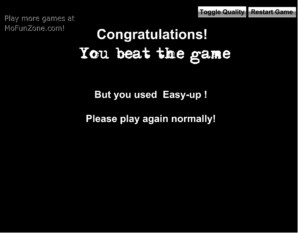
Upon beating the game, there was a very anticlimactic black screen informing me that I beat the game. These days, infinite replayability is demanded of all games, but that wasn’t the case back in the day. It wasn’t a trend or even an expectation. Considering many Flash gamers were kids playing on the computer for forty-five minutes at a time, they were most attracted to free, casual games. Then came Runescape …
There are a few things that Battle Arena did really well. First of all, Krinn nailed the ninja theme. This was among the most popular genres back then. The tick system, though not advanced, was way ahead of its time and made for some interesting battles. Taken for granted now, the fact that the user had choices to make added a lot of depth to the game.
Today, it is obvious what needs to be improved. There was an NPC that provided advice, but some fights were still very difficult. It takes a lot of trial and error–or reading diatribes by people in the comments section–to form a coherent plan of attack on the hardest difficulty setting. The combat system ends up being completely reliant on spam-clicking and the final boss is (dare I say) impossible without loading up on the shield skill. The challenge ends up coming down to figuring out how to rely on your shield, though with perfect timing I was able to beat what I’d imagine is the second-hardest boss by exploiting a well-known glitch in which I could keep attacking despite being at zero or negative hitpoints.
The music is on a short loop and ends up being very annoying. Some of the sounds were derided as being generic sounds from RPG Maker 2000.
If we’re talking simple improvements, a hotkey system for attacks was desperately needed. The attack tiles would all disappear when you were in cooldown, so that fraction of a second moving your most to the new tile could often be the difference between winning or losing. There also needed to be adjustments to the difficulty curve making it possible to beat the game without a very specific skill-tree arrangement, along with the option to re-spec the skill tree and exit the portal if you were faced with an impossible battle.
Overall, for 2003, I can’t really complain. If you want evidence of how it was received in its era, just check the comments on Newgrounds, people were fascinated by this game. Krinn responded to many comments and revealed that this game was a trial run for the game engine for a more complete game (which ended up being Sinjid: Shadow of the Warrior):
The cheats were just a little add on feature. The actual fun was just playing the game. However, as you said, there is a lot of battling, because this game is merely a demonstration of the my Battle Engine that we’re planning to use for the upcoming Sinjid RPG which will be a full game with a story.
Sinjid: Shadow of the Warrior
I vividly remember playing this game in 2005 and 2006. It blew the doors off most other free Flash games at the time. During one period in which I was taking a break from playing Runescape, this game provided surprising depth for a few playing sessions.
In just a year’s time, Krinn really improved his skills and teamed up with other talented artists and musicians to make a really special game. If we’re talking about the best Flash RPGs from this era, I don’t see how this couldn’t be in the top 3.
In this game, we get an expanded concept. Now, there are roughly 12 different rooms and 3 different portals. The combat system has shifted to turn-based, which makes it a little less lively but it still works. We see more advanced RPG elements creep in. For one, a more versatile skill tree:
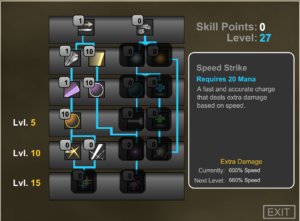
You also have a classic leveling system with stats like strength, speed, life, and mana. At the beginning of the game, you can choose a class, which influences the extent to which each stat increases each time you gain a level. There’s also an expanded gear selection. Sadly, no randomness to the item generation, but the game probably has about 30 unique pieces of gear that the player can wield.
In addition to mana and the obvious implication of magic, there are new physical/magical offense/defense stats along with shields being a piece of equipment rather than an optional skill that ends up being required.
There’s more of a plot to the game, and there are two, albeit very minor, sidequests. What we really care about are the fights. You have a human portal with 20 fights. A monster portal with 20 fights. A final boss portal with 5 fights. And also an instanced training portal that can be accessed throughout the game.
The game flows smoothly with two flaws from the predecessor fixed sufficiently. The overarching feeling is that the game feels more balanced. While checks and balances could introduce a grinding element, the main factor in every one of my playthroughs has been excitement. In the previous game, you could only train in the monster portal which got progressively harder. In this game, you can train using the training ward which has 3 difficulty settings.
You can’t abuse the portal, because your stats like health and mana are still drained–the ward you train on fights back. There’s a new power meter in the game called energy, and this will be expended at a fast rate while training. You have to spend gold on food to recover it, but you can’t get gold from the training portal. Thankfully, there is a tedious minigame-sidequest in which you can take herbs from a merchant to a medicine-lady then back to the merchant to earn a meager sum of gold. If you end up having to grind this out, it means you messed up, but it’s a masterwork as far as game balances go.
The AI in this game is not too smart, but the challenge scales well. The game demands that you spend some time in the training portal, don’t slack on upgrading your gear, and remain stocked on potions. Mid-game, things start to spice up as you can alternate between the late levels of the human portal and the earlier levels of the slightly-harder monster portal. It flows really well and there’s a sense of accomplishment here. This is unprecedented for a flash game of this era, and I was really surprised with how fun my most recent playthrough was.
You can only enter the final chamber, containing the Dark Rift portal, after you complete the others. In there, you find two merchants selling god-tier items. You’ll need them, and, brilliantly, you should be able to afford most of what you need by the time you get to the second boss, which was, for me, the hardest in the game. I still felt a tiny dopamine rush when purchasing the superweapons in this final room, so I know that when I was a kid this was an awesome gaming moment.
In fact, I remember playing this game as a kid while talking to a girl I liked on AOL Instant Messenger. She wanted to meet at a cafe near where we lived. Kind of weird for 11-year-olds, in retrospect. I vividly remember strolling up to that cafe, walking in, buying a Fiji water, seeing the girl, being too scared to say anything, then walking home and playing this game. Shortly after she IMed me a strong “WTF?”
Digression aside, I had to gain about 6 levels while trying to beat the second of five bosses here. I think the “right” move is to spec into the healing spell (sound familiar?) but I didn’t. So I instead had to get my attack power to the point that I could win in roughly 12 attacks (down from 17) and hope that RNG didn’t bite me. From there, the last few bosses were a cakewalk.
As you beat all the portals, you can… walk out the door(?) of the main area for a sudden cutscene and slightly-less obtrusive ending sequence compared to the first game. Even if you’re playing optimally, which I must have been pretty close to, you can get a solid four hours of playing time out of this game as an adult, and there are plenty of ways it can be accomplished. When “replayability” means starting from the beginning, this is a highly-replayable game.
If we’re talking about sequels, Krin nailed it here. The improvements I’d ask for would be very minor. If you end up on the herbal-gold-grind late game, it’s awful. It would be nice to have the value boosed from 3 to 10 once you unlock the final room. Something like that. The ability to re-spec your skills would also be nice. The knowledge of more major skill boosts occurring dependably every 5 levels would be extremely useful, as well. The potions are also underpowered during the late game, as some enemies can hit for more than they can heal.
The game is balanced well, but the Blood Spirit (boss #2 in the Dark Rift) requires you to tank-ify your character. Conquering it as the stealth class was really annoying. To that point, stealth classes seem generally exposed to magic attacks. I think that magic attacks should be dodgeable, like melee attacks.
The improvement between the first game and SotW is deserving of special praise. This game is a Flash Hall of Fame candidate.
Sinjid: ???
Here’s where we need to ask the question: What happened? Sinjid: SotW was a hit. As greedy consumers, we expect that creators will just keep giving us what we want. Over the next few years, Krin continued releasing about one game every year. This span of time also seemed to overlap with when the creator went to college, without getting too personal.
Knowing what we know now, if Krinn took Sinjid: SotW and expanded it, cleaned up the graphics, added some metagame and some randomness, and then ported it to an early iOS version, it would have been a megahit. Of course, this is easier said than done. I speculate that this creator may have been making a decent amount of money in partnership with ArmorGames, so it didn’t matter what he was releasing as much as it did that it was a great product. No disrespect either, because the Sonny series is considered a Flash classic as well.
Sinjid
Simply named, Sinjid ties off the trilogy in a dramatic fashion. There are few independent game developers who can showcase growth on par with Krinn’s over the decade 2004 – 2013. From Sinjid: Battle Arena to Sinjid [3], it’s incredible! The evolution of art, music, gameplay, plot, it’s all there. This is a truly professional product only released on ArmorGames. It’s likely that few of the original, original fans even know this game existed. I didn’t! I just recently played it for the first time.
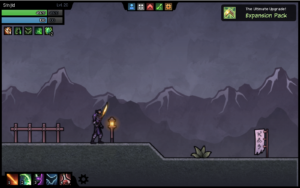
The game is a silky-smooth well-styled side-scrolling hack-n-slash. It is such an advancement from the previous title that your first instinct will be to check if you missed some intermediate entries in the series. It’s a really sharp indie game that holds up even in 2020.
This game actually has a significant story to it and serves to tie-off the Sinjid plot. Truth be told, nobody really remembers what the plot was, and the ending here is anticlimactic and kind of cliche, but it still feels good to get closure. The plot references seven years that have elapsed since the past game, which suggests the game was in development for some amount of time, since it wasn’t released until roughly nine years after the previous one. Here is Krinn’s last post on Newgrounds where he announces the game:
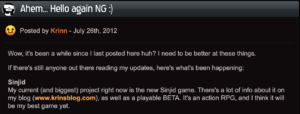
The game is fun and contains quite a few side quests in addition to the main questline. In addition, there are drop tables for enemies, enemies re-populate at each location, items can be upgraded, combat is back to a game tick system, and there are even set effects for certain item sets. Combat is electric with chains of hits, critical hits, tons of buffs and debuffs, blocking–again, it feels like a different game but it feels like everything we would have asked for in 2004. Here’s the world map:
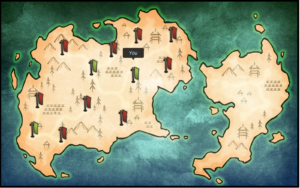
Sinjid, ultimately, doesn’t work for me. I can’t bring myself to like it. While there’s a clean hotkey system, combat, at least for the assassin, consists of click-spamming similar to the first game. The semi-open map is nice, but the time to complete the game becomes bounded by walking speed, not combat speed, which starts to be annoying. The difficulty curve is decent, as the second-to-last boss cannot be defeated without careful strategizing, even while playing on the beginner setting.
What really stung for me was the dialogue. Listen, I get that we’re not going to hire voice actors for a Flash game, but I was surprised by how contrived, casual, and childish the dialogue within the game was. I know that the ninja/samurai genre isn’t known for wonderful cutscenes, but it seriously struck me as if the creator wrote out the entire plot, line for line, back in 2004 and pledged not to change things like vocabulary and sentence structure. If so, bravo on taking on a childhood dream as an adult, but I don’t think that’s what happened here. It felt like an afterthought or as if it was outsourced. It stands at odds with the beautiful level design and extremely professional sound effects and soundscapes.
Next, there is a pay-to-play aspect of the game which the creator is entitled to but which diminishes any sense of endgame. Your level is capped at 20, and when the story ends you’re just supposed to figure out that you can continue by purchasing the add-on content. In case you forget, it’s dangled there as an ad during the hour or so that it takes to actually complete the game. I’m not saying this is wrong, but it feels wrong now that the game is vintage and may shortly be unplayable.
The game has a serious wow factor but lacks the charm and quirky fun of the first two games. It plays like a serious RPG, but it can be slashed through incredibly quickly with game mechanics recycled from newer titles by the author, to the point that I suspect this was more to bring finality to the storyline than anything else.
Conclusion
It is obvious to us that the man who created these games was a really smart guy, likely precocious and well ahead of his peers as a young man when he published his first titles. 99 times out of 100, a creator fitting this profile would never start a series when he was in high school only to finish it up after graduating from college. The creator would get the corporate job he deserved and would never create Sinjid 3. What actually happened is that Krin created Sinjid 3. It’s implausible that it happened. I might be one of the few people on the internet to notice this, or recognize the significance of this, but it does matter to me. It deserves to be celebrated, it deserves to be dissected like any other item of cultural significance.
The Sinjid series was whatever you might call it–a sleeper hit, an indie success, a complete enigma, a likely candidate for r/TipOfMyJoystick topics on Reddit. The truth is that RPG games aren’t easy to make. They aren’t cheap to make. Now that creating games is significantly easier than the Flash days, there’s value in prospecting this era. Through analyzing the Sinjid series, we can understand some of the most fundamental and essential parts of what makes games fun.
Additionally, we can exhibit Sinjid: SotW as a sublime artifact, transcending its impact on game design is its influence on very impressionable kids who came to realize that that one person coded this and maybe I could learn too. Thank you.

